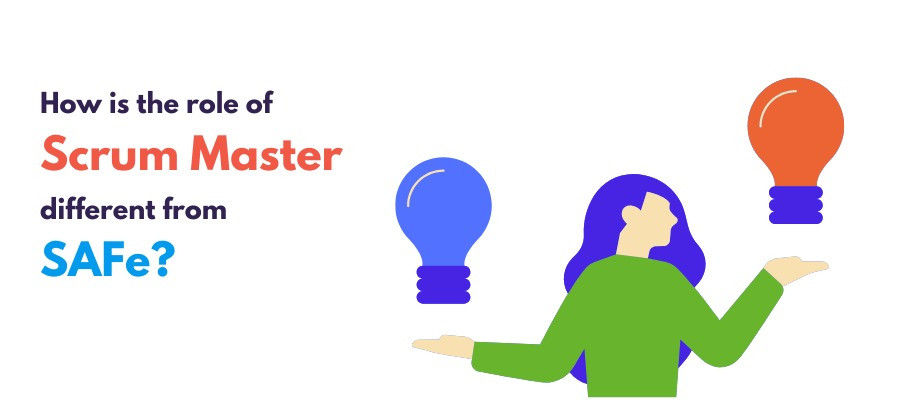How is the role of Scrum Master different in SAFe®?

Are you Learning about different Agile Methodologies and Approaches? Then you might have come across the topics covering Scaled Agile Framework (SAFe®) and Scrum Framework. Even though both SAFe® and Scrum are Agile Methodologies, each has different roles, responsibilities, and best practices. Naturally, the role of a Scrum Master comes with varying responsibilities in both approaches. This guide discusses the main differences between the Scrum Master’s role in SAFe® and Scrum. So keep reading!
Characteristics of the Scrum Master in SAFe®:
The SAFe® Scrum Master’s primary responsibility is accelerating the Agile Teams towards achieving the Product Goal. Indeed, it’s an essential responsibility to perform, which ensures the overall project’s success. So it’s a must for the Certified Scrum Master to have the following characteristics:
- Leadership capabilities: SAFe®Scrum Master must act as the Agile Leader who drives the team towards the end goals. He also must have a good understanding of organizational values and best practices.
- Consistent Navigator: SAFe®Scrum Master leads the way for the development teams to follow. He acts as the consistent team navigator towards achieving successful deliverables.
- Mentor & Coach: The Scrum Master should act as a mentor and Agile Coach, conducting frequent Agile Training sessions and workshops with the development teams.
- Good Knowledge of SAFe®: The Scrum Master should have in-depth knowledge of the SAFe framework and best practices. With a proper understanding of SAFe, it becomes easier to assist other team members in understanding SAFe® workflows.
- Approachable: SAFe® Scrum Master should be empathetic towards the teams so anyone can approach him to clarify doubts or get assistance with a particular Work Item.
- Conflict Resolver: Whenever there is any team conflict or miscommunication, the SAFe® Scrum Master should act promptly to resolve the disputes.
It’s not a necessity to have all the above qualities in the SAFe® Scrum Master. The CSM can acquire these capabilities with learning, training, and experience.
Responsibilities of the Scrum Master in SAFe®:
The Scrum Master in SAFe® fulfils many critical responsibilities, such as:
Facilitating PI Planning:
The Scrum Master performs Program Increment (PI) Planning along with the other project’s Scrum Masters and Release Train Engineers. He also conducts the following activities:
- Prepare for PI Planning by briefing on upcoming product features through the Product Owner.
- Draft PI plans and objectives based on identifying potential program risks and issues.
- Coordinate with other teams, SMEs, and program stakeholders to determine how the collaboration will happen for feature development.
- Create team-oriented PI objectives to target accomplishing in the upcoming PI.
- Review the final plans and complete business value assignments.
Support Iteration Execution:
The Certified Scrum Master supports the development teams through the PI Iterations. It increases the team's focus on achieving the coming PI's iteration goals and objectives. Here is the workflow sequence:
- The Scrum Master facilitates ScrumXP events involving the Agile Teams.
- As an Agile Leader, CSM manages the events of Backlog Refinement, Daily Stand-Up, Iteration Planning, Review, and Retrospective.
- CSM collaborates with the Product Owner to maximize the solution's business value.
Improving Flow:
SAFe® Scrum Master is responsible for implementing a Kanban System that fulfils the organization's Agile Team requirements. He uses the Kanban Board to visualize the ongoing workflow and find enhancement areas for the Developers to work on.
The CSM establishes a system of metrics using specific measures for Competency, Flow, and Outcomes. The Flow Metrics greatly help improve the workflow of Agile Teams. With the flow-based system, Agile Teams develop faster and release excellent business capabilities. It enables the Agile Teams to efficiently create and execute multiple test cases at different tiers.
Building High-Performing Teams:
The SAFe® Scrum Master actively forms Agile Teams that can generate higher-value working solutions and feature increments. TheSAFe®CSM encourages the Agile Teams to achieve the following attributes:
- Become self-organizing so that the Developers can take ownership of the project goals.
- Align with the business requirements and improve the overall team collaboration.
- Work dedicatedly to meet clear Product Goals set by the Product Owner.
- Act as influential decision-makers who can resolve conflicts and overcome challenges healthily.
To become a successful SAFe® Scrum Master, the Agile Practitioner must know how to build high-functioning Agile Teams. So he should become an Agile Coach to train the teams about various SAFe® Agile approaches and best practices. The more engagement the team members show, the easier it becomes to transition them into becoming high-functioning Agile Teams.
Conclusion
It’s now evident that the SAFe® Scrum Master has different roles, responsibilities, and characteristics than a Scrum Master in Agile Scrum. SAFe® Scrum Master is an Agile Leader who collaborates with the Product Owner and Business Stakeholders to collect all business requirements. He actively forms Agile Teams, performs PI planning, manages Iteration Workflow, and ensures smooth delivery to the business. He also inspires the Agile Teams in self-organizing and Agile Training as an Agile Coach. If the SAFe® Scrum Master succeeds in matching all his responsibilities, the Agile Teams succeed in delivering the expected outcomes to the business!
Reference
- https://www.scaledagileframework.com/scrum-master/



